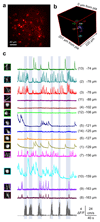Random-access scanning microscopy for 3D imaging in awake behaving animals
- PMID: 27749836
- PMCID: PMC5769813
- DOI: 10.1038/nmeth.4033
Random-access scanning microscopy for 3D imaging in awake behaving animals
Abstract
Understanding how neural circuits process information requires rapid measurements of activity from identified neurons distributed in 3D space. Here we describe an acousto-optic lens two-photon microscope that performs high-speed focusing and line scanning within a volume spanning hundreds of micrometers. We demonstrate its random-access functionality by selectively imaging cerebellar interneurons sparsely distributed in 3D space and by simultaneously recording from the soma, proximal and distal dendrites of neocortical pyramidal cells in awake behaving mice.
Conflict of interest statement
The authors declare competing financial interests: details accompany the full text HTML version of the paper at
Figures



References
-
- Kaplan A, Friedman N, Davidson N. Acousto-optic lens with very fast focus scanning. Opt Lett. 2001;26:1078–1080. - PubMed
MeSH terms
Substances
Grants and funding
LinkOut - more resources
Full Text Sources
Other Literature Sources
Molecular Biology Databases

